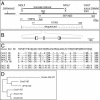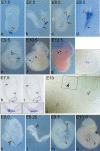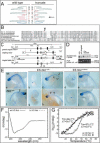The mouse homeobox gene Not is required for caudal notochord development and affected by the truncate mutation
- PMID: 15231714
- PMCID: PMC478193
- DOI: 10.1101/gad.303504
The mouse homeobox gene Not is required for caudal notochord development and affected by the truncate mutation
Abstract
The floating head (flh) gene in zebrafish encodes a homeodomain protein, which is essential for notochord formation along the entire body axis. flh orthologs, termed Not genes, have been isolated from chick and Xenopus, but no mammalian ortholog has yet been identified. Truncate (tc) is an autosomal recessive mutation in mouse that specifically disrupts the development of the caudal notochord. Here, we demonstrate that truncate arose by a mutation in the mouse Not gene. The truncate allele (Nottc) contains a point mutation in the homeobox of Not that changes a conserved Phenylalanine residue in helix 1 to a Cysteine (F20C), and significantly destabilizes the homeodomain. Reversion of F20C in one allele of homozygous tc embryonic stem (ES) cells is sufficient to restore normal notochord formation in completely ES cell-derived embryos. We have generated a targeted mutation of Not by replacing most of the Not coding sequence, including the homeobox with the eGFP gene. The phenotype of NoteGFP/eGFP, NoteGFP/tc, and Nottc/tc embryos is very similar but slightly more severe in NoteGFP/eGFP than in Nottc/tc embryos. This confirms allelism of truncate and Not, and indicates that tc is not a complete null allele. Not expression is abolished in Foxa2 and T mutant embryos, suggesting that Not acts downstream of both genes during notochord development. This is in contrast to zebrafish embryos, in which flh interacts with ntl (zebrafish T) in a regulatory loop and is essential for development of the entire notochord, and suggests that different genetic control circuits act in different vertebrate species during notochord formation.
Copyright 2004 Cold Spring Harbor Laboratory Press ISSN
Figures





References
-
- Ades S.E. and Sauer, R.T. 1994. Differential DNA-binding specificity of the engrailed homeodomain: The role of residue 50. Biochemistry 33: 9187-9194. - PubMed
-
- Amacher S.L. and Kimmel, C.B. 1998. Promoting notochord fate and repressing muscle development in zebrafish axial mesoderm. Development 125: 1397-1406. - PubMed
-
- Ang S.L. and Rossant, J. 1994. HNF-3b is essential for node and notochord formation in mouse development. Cell 78: 561-574. - PubMed
Publication types
MeSH terms
Substances
LinkOut - more resources
Full Text Sources
Molecular Biology Databases
Research Materials
